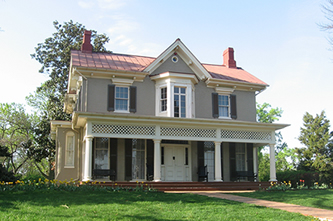
Courtesy of National Park Service
In February of 1817, Douglass was born into slavery on the eastern shore of Maryland and given the name Frederick Augustus Washington Bailey, after his mother Harriet Bailey. Learning to read and write at an early age, Douglass realized that this was the key to his freedom. Douglass read newspapers, political materials, and an array of books that exposed him to an entirely new realm of thought and led to his questioning and condemnation of slavery. In 1838, at the age of 21, he escaped to the North, where he changed his name to Douglass to avoid recapture and began his active involvement in the abolitionist movement. By 1841, he was an agent of the Massachusetts Anti-Slavery Society, and by 1845, he published his most famous work, his autobiography, The Narrative of the Life of Frederick Douglass.
Because of the book’s success, Douglass became so well known that he feared recapture by his owner. Douglass fled to England where Quakers purchased his freedom. Returning to the United States in 1847, Douglass settled in Rochester, New York, where within 10 years he became a well-known lecturer, leader of Rochester’s Underground Railroad, and the editor and publisher of the North Star, an abolitionist newspaper.
By the time of the Civil War, Douglass was one of the most famous black men in the country. Throughout the war, Douglass promoted equality and freedom and championed the use of African American soldiers in the war. Douglass and one of his sons supported the Union by serving as recruiters for the 54th Massachusetts Regiment, while his other son fought with this regiment during the Battle of Fort Wagner. By 1865, slavery was outlawed everywhere in the United States by the post-war ratification of the 13th Amendment. Following the war, Douglass continued to serve the American people by working for civil rights for all oppressed peoples.
In 1877, Douglass purchased what would be his final home, an estate on a hill in Anacostia in southeast Washington, DC surrounded by cedar trees and with a commanding view of the river and city. Douglass named his home Cedar Hill. He paid $6,700 to the Freedman’s Savings and Trust Company for the home and a little over nine acres of land. By purchasing the estate, Douglass became one of the first black men to break a covenant in Washington, DC. Even though the original deed prohibited blacks from purchasing the estate, Douglass was able to purchase the home.
Between 1878 and 1895, Douglass spent much of his time and money improving Cedar Hill. He expanded the house from 14 to 21 rooms and enlarged his property to 15 acres by purchasing adjoining lots. He furnished the home with art, antiques, and a china closet and added a new library and a second story bedroom. The library contained more than 1,000 works on topics ranging from history, to religion, science, and government. The library also showcased portraits of prominent figures Douglass respected and admired, such as John Brown, Susan B. Anthony, and William Lloyd Garrison.
Today the house is furnished much as it was when Douglass lived in it from 1878 until his death in 1895. The rooms at Cedar Hill still contain Douglass’ belongings and items from his public and personal life that help to preserve and illustrate the legacy and story of this influential figure. Douglass’ roll-top desk sits in the library, while his Panama hat and clothing are on display in his bedroom. The rooms are also filled with gifts from prominent antislavery figures of Douglass’ time, including President Abraham Lincoln and Harriet Beecher Stow. The spaciousness and lavishness of Cedar Hill serve as a testament to Douglass’s lifelong journey from enslavement to freedom. His story is symbolic of the journeys of thousands of African Americans, a profoundly American story.
Frederick Douglass National Historic Site, a unit of the National Park System, is located at 1411 W Street SE, in Washington, DC. The site is open from April 16 through October 15 from 9:00am to 5:00pm and from October 16 through April 15 from 9:00am to 4:00pm. For more information, visit the Frederick Douglass National Historic Site website or call 202-426-5961.
Last updated: June 17, 2019
